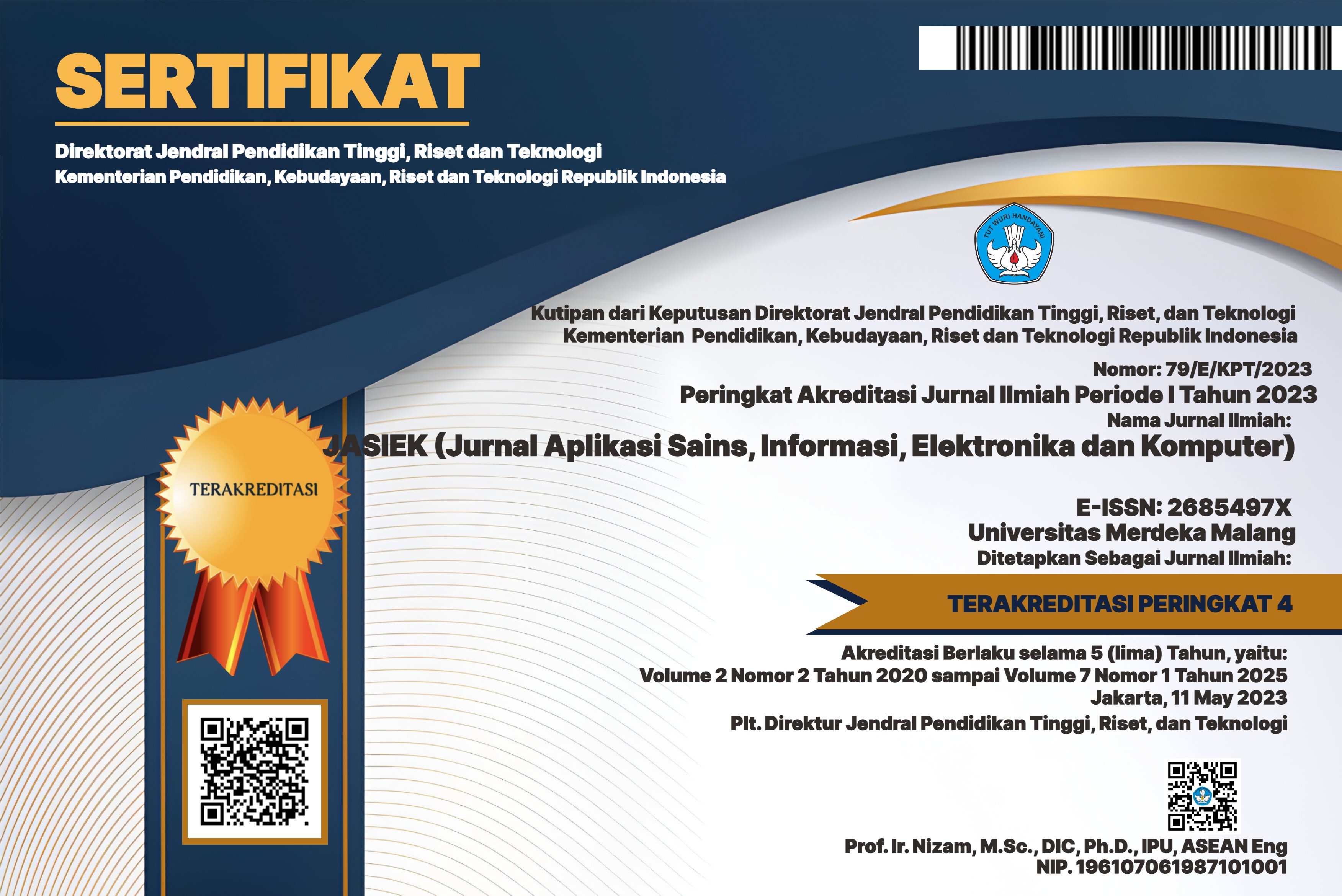Prediksi Keterlambatan Pembayaran Mahasiswa untuk Mitigasi Risiko Cuti Menggunakan SVM Optimasi PSO
DOI:
https://doi.org/10.26905/jasiek.v7i1.15483Keywords:
Mahasiswa, Particle Swarm Optimization (PSO), Prediksi keterlambatan pembayaran, Support Vector Machine (SVM)Abstract
Delayed tuition payments present challenges for higher education institutions, impacting both financial stability and students’ academic progress. This study proposes a predictive model using Support Vector Machine (SVM) optimized by Particle Swarm Optimization (PSO) to identify students at risk of payment delays. The dataset includes academic and social attributes. A dot kernel SVM was evaluated using 10-fold cross-validation. Results show that PSO optimization significantly improved model performance, particularly in recall, which increased from 36.10% to 65.51%, indicating better identification of delayed payment cases. The analysis also reveals that social factors, such as employment and academic status, strongly influence prediction outcomes. These findings highlight the potential of the SVM-PSO model as a decision-support tool for early intervention, enabling institutions to mitigate dropout risks and enhance financial planning. By leveraging this approach, universities can better support students while maintaining administrative efficiency and institutional sustainability.
Downloads
References
[1] Ridwansyah, M. Iqbal, H. Destiana, Sugiono, and A. Hamid, “Data Mining Berbasis Machine Learning Untuk Analitik Prediktif Dalam Kelulusan,” semanTIK, vol. 10, no. 2, pp. 1–10, 2024, doi: https://doi.org/10.55679/semantik.v10i2.67.
[2] A. H. Kahfi, T. Prihatin, Yudhistira, A. Sudradjat, and G. Wijaya, “The right steps towards graduation: nb-pso smart combination for student graduation prediction,” J. Tek. Inform., vol. 5, no. 2, pp. 607–614, 2024, doi: https://doi.org/10.52436/1.jutif.2024.5.2.1889.
[3] Sumarna, I. Nawawi, Suhardjono, Hari Sugiarto, and D. Yuliandari, “Meningkatkan akurasi prediksi kelulusan mahasiswa menggunakan metode algoritma genetika,” J. Inform. Manaj. dan Komput., vol. 16, no. 2, 2024, doi: http://dx.doi.org/10.36723/juri.v16i2.706.
[4] W. Li, “Design of Financial Crisis Early Warning Model Based on PSO-SVM Algorithm,” Math. Probl. Eng., pp. 1–8, 2022, doi: https://doi.org/10.1155/2022/3241802.
[5] S. Anam, M. R. A. Putra, Z. Fitriah, I. Yanti, N. Hidayat, and D. M. Mahanani, “Health Claim Insurance Prediction Using Support Vector Machine With Particle Swarm Optimization,” BAREKENG J. Ilmu Mat. dan Terap., vol. 17, no. 2, pp. 0797–0806, 2023, doi: 10.30598/barekengvol17iss2pp0797-0806.
[6] N. W. D. Ayuni, N. N. Lasmini, and K. C. Dewi, “Predicting financial distress of property and real estate companies using optimized support vector machine-particle swarm optimization (SVM-PSO),” Bull. Soc. Informatics Theory Appl., vol. 8, no. 1, pp. 97–106, 2024.
[7] W. Widayani and H. Harliana, “Analisis Support Vector Machine Untuk Pemberian Rekomendasi Penundaan Biaya Kuliah Mahasiswa,” J. Sains dan Inform., vol. 7, no. 1, pp. 20–27, 2021, doi: 10.34128/jsi.v7i1.268.
[8] N. Y. L. Gaol, “Prediksi Mahasiswa Berpotensi Non Aktif Menggunakan Data Mining dalam Decision Tree dan Algoritma C4.5,” J. Inf. Teknol., vol. 2, pp. 23–29, 2020, doi: 10.37034/jidt.v2i1.22.
[9] H. Nurdin, I. Carolina, R. L. Andharsaputri, A. Wuryanto, and Ridwansyah, “Forward Selection as a Feature Selection Method in the SVM Kernel for Student Graduation Data,” Sink. J. dan Penelit. Tek. Inform., vol. 8, no. October, pp. 2531–2537, 2024, doi: 10.33395/sinkron.v8i4.14172.
[10] M. J. Budiman and Fanny Jouke Doringin, “Penerapan algoritma c5.0 dalam memprediksi keterlambatan pembayaran biaya kuliah di unkriswina sumba,” J. Ilmu Komput. Revolusioner, vol. 8, no. 6, 2024.
[11] J. J. Purnama, H. M. Nawawi, S. Rosyida, Ridwansyah, and Risandar, “Klasifikasi Mahasiswa Her Berbasis Algortima Svm Dan Decision Tree,” J. Teknol. Inf. dan Ilmu Komput., vol. 7, no. 6, pp. 1253–1260, 2020, doi: 10.25126/jtiik.202073080.
[12] A. Hamid and Ridwansyah, “Optimizing Heart Failure Detection : A Comparison between Naive Bayes and Particle Swarm Optimization,” Paradigma, vol. 26, no. 1, pp. 30–36, 2024, doi: https://doi.org/10.31294/p.v26i1.3284.
[13] B. Gunawan Sudarsono and A. Ulan Bani, “Prediksi Mahasiswa Berpotensi Berhenti Kuliah Secara Sepihak Menggunakan Data Mining Algoritma C4.5,” J. Sains Komput. Inform., vol. 4, no. 2, pp. 359–367, 2020, [Online]. Available: https://tunasbangsa.ac.id/ejurnal/index.php/jsakti/article/view/227.
[14] D. F. D. Putra, Y. Suhanda, and M. Susanti, “Sistem Informasi Prediksi Mahasiswa Putus Kuliah Menggunakan Metode Data Mining Dengan Algoritma Chaid,” J. Ilm. FIFO, vol. 13, no. 2, p. 133, 2021, doi: 10.22441/fifo.2021.v13i2.003.
[15] T. Azhima, Y. Siswa, and W. J. Pranoto, “Implementasi Seleksi Fitur Information Gain Ratio Pada Algoritma Random Forest Untuk Model Data Klasifikasi Pembayaran Kuliah,” Din. Inform., vol. 15, no. 1, pp. 41–49, 2023.
[16] T. Triase and S. Samsudin, “Implementasi Data Mining dalam Mengklasifikasikan UKT (Uang Kuliah Tunggal) pada UIN Sumatera Utara Medan,” J. Teknol. Inf., vol. 4, no. 2, pp. 370–376, 2020, doi: 10.36294/jurti.v4i2.1711.
[17] Yennimar, W. Leonardi, H. Weide, D. Cantona, and Gani Mores Hutagalung, “Comparison of data mining algorithms (random forest, C4.5, catboost) based on adaptive boosting in predicting diabetes mellitus,” J. Tek. Inform. C.I.T Medicom, vol. 16, no. 3, pp. 01–12, 2024, [Online]. Available: www.medikom.iocspublisher.orgjournalhomepage:www.medikom.iocspublisher.org.
[18] R. Ridwansyah, G. Wijaya, and J. J. Purnama, “Hybrid Optimization Method Based on Genetic Algorithm for Graduates Students,” J. Pilar Nusa Mandiri, vol. 16, no. 1, pp. 53–58, 2020, doi: 10.33480/pilar.v16i1.1180.
Downloads
Published
Issue
Section
License
Copyright (c) 2025 JASIEK (Jurnal Aplikasi Sains, Informasi, Elektronika dan Komputer)

This work is licensed under a Creative Commons Attribution-NonCommercial-ShareAlike 4.0 International License.
Authors who publish with this journal agree to the following terms:
The journal allow the authors to hold the copyright without restrictions and allow the authors to retain publishing rights without restrictions.
Authors retain copyright and grant the journal right of first publication with the work simultaneously licensed under a Creative Commons Attribution-ShareAlike 4.0 International License that allows others to share the work with an acknowledgement of the work's authorship and initial publication in this journal.
Authors are able to enter into separate, additional contractual arrangements for the non-exclusive distribution of the journal's published version of the work (e.g., post it to an institutional repository or publish it in a book), with an acknowledgement of its initial publication in this journal.
Authors are permitted and encouraged to post their work online (e.g., in institutional repositories or on their website) prior to and during the submission process, as it can lead to productive exchanges, as well as earlier and greater citation of published work (See The Effect of Open Access).

This work is licensed under a Creative Commons Attribution-ShareAlike 4.0 International License.










